Stress and anxiety can be real mood dampeners, but you don’t have to let them take control. Here are five straightforward mindfulness exercises that you can try anytime, anywhere, to help ease those worries and bring a bit of calm to your day. Dive right in and find what works best for you!
Mindful Walking in Nature

Walking in nature is a wonderful way to practice mindfulness. Imagine a peaceful trail surrounded by tall trees and a clear blue sky. This serene setting invites you to slow down and really take in your surroundings.
Notice the details around you. Feel the crunch of the leaves or pine needles underfoot. Listen to the rustling leaves and the distant sounds of birds. Engaging with these sensations helps quiet the mind and reduce stress.
Mindfulness exercises like this encourage you to be present. You can leave your worries behind while immersing yourself in nature’s calm. It’s a simple practice that can lead to greater peace and clarity in daily life.
Guided Visualization for Relaxation
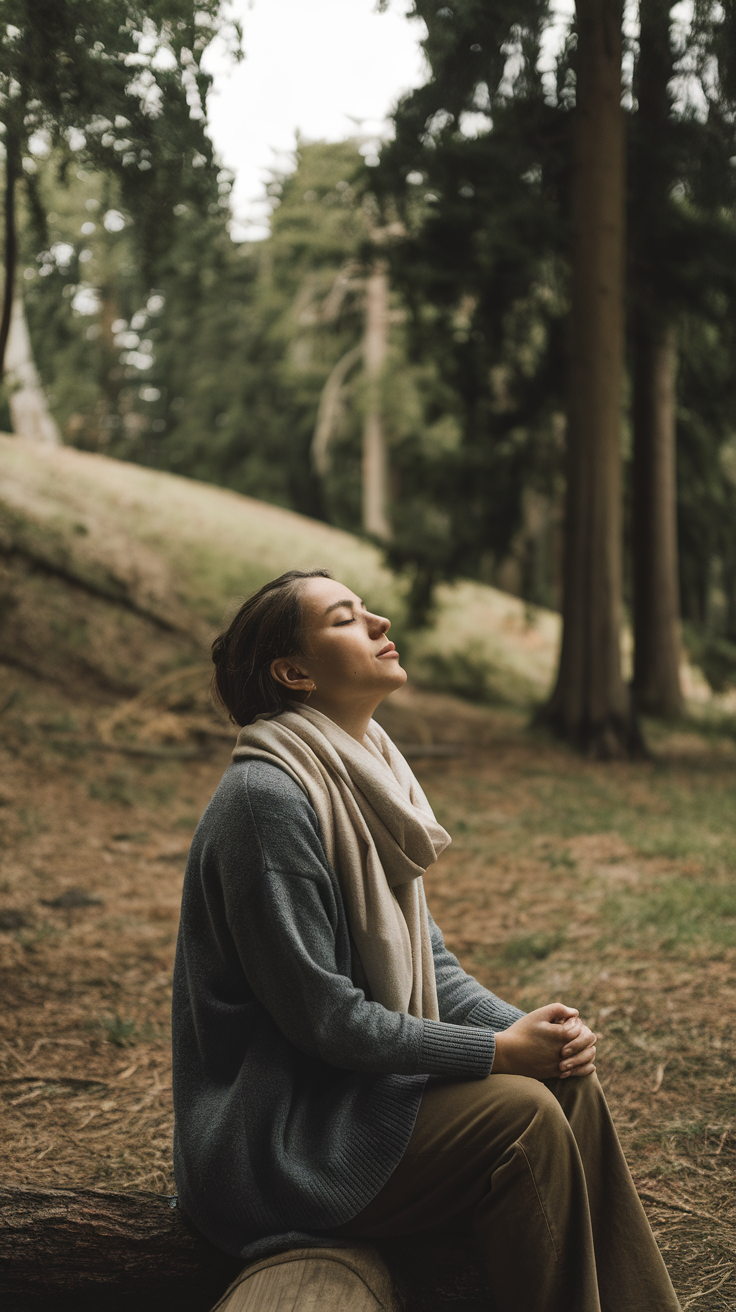
Guided visualization is a powerful mindfulness exercise that helps calm the mind and body.
Close your eyes and take a deep breath. Imagine the warmth of the sun on your skin and the gentle rustling of leaves. This simple practice can transform your mental state.
By focusing on calming images and sensations, you allow stress and anxiety to fade away. Think of this exercise as a mini-vacation for your mind. When you visualize peaceful scenes, your body responds by relaxing, helping you feel rejuvenated.
Try incorporating guided visualization into your daily routine. You can do this for just a few minutes, allowing yourself to drift into a state of tranquility. Over time, you’ll likely find it easier to access this calm state whenever you need it.
Deep Breathing Techniques for Calmness
Deep breathing is a simple yet effective way to find calmness. It helps slow down the mind and relax the body. When you take deep breaths, you can feel the tension melting away. Imagine sitting by that tranquil water, inhaling fresh air, and exhaling all the worries of the day.
To try this, find a quiet spot. Sit comfortably, close your eyes, and take a slow, deep breath in through your nose. Hold it for a moment, then release it through your mouth. Repeat this several times. You might notice how your body begins to relax.
Combining deep breathing with mindfulness exercises allows you to focus on the present. You can visualize something peaceful, which helps further reduce stress. The blend of nature and breathing creates a soothing experience that can be done anywhere.
Loving-Kindness Meditation for Compassion
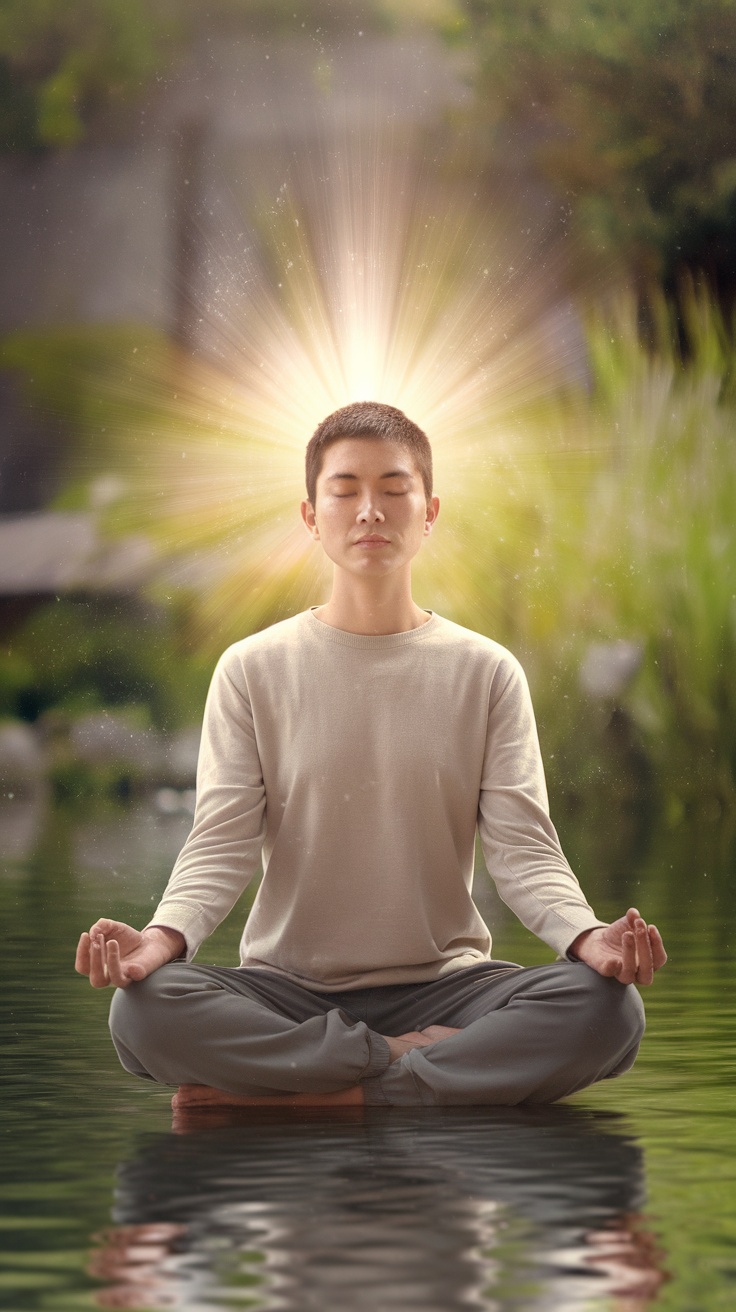
Loving-kindness meditation is a beautiful way to cultivate compassion. It encourages you to send good wishes and kindness to yourself and others. The image perfectly captures the essence of this practice. We see someone meditating peacefully, surrounded by nature. The soft glow around them symbolizes the warmth of compassion. It’s a reminder of how mindfulness exercises can create a sense of peace.
In this practice, you start by focusing on yourself. Silently repeat phrases like, ‘May I be happy. May I be healthy.’ This sets a loving tone. Next, you expand your focus to loved ones, acquaintances, and even people you find challenging. Each time you say these phrases, you invite more compassion into your heart. This not only helps in reducing stress and anxiety but also fosters a deeper connection to others.
Trying this meditation regularly can be transformative. You may notice a shift in how you view yourself and those around you. By cultivating kindness, you’re not just bringing peace to your mind but also to your relationships. It’s a simple yet powerful mindfulness exercise that anyone can incorporate into their daily life.
Gratitude Journaling for Positive Thinking
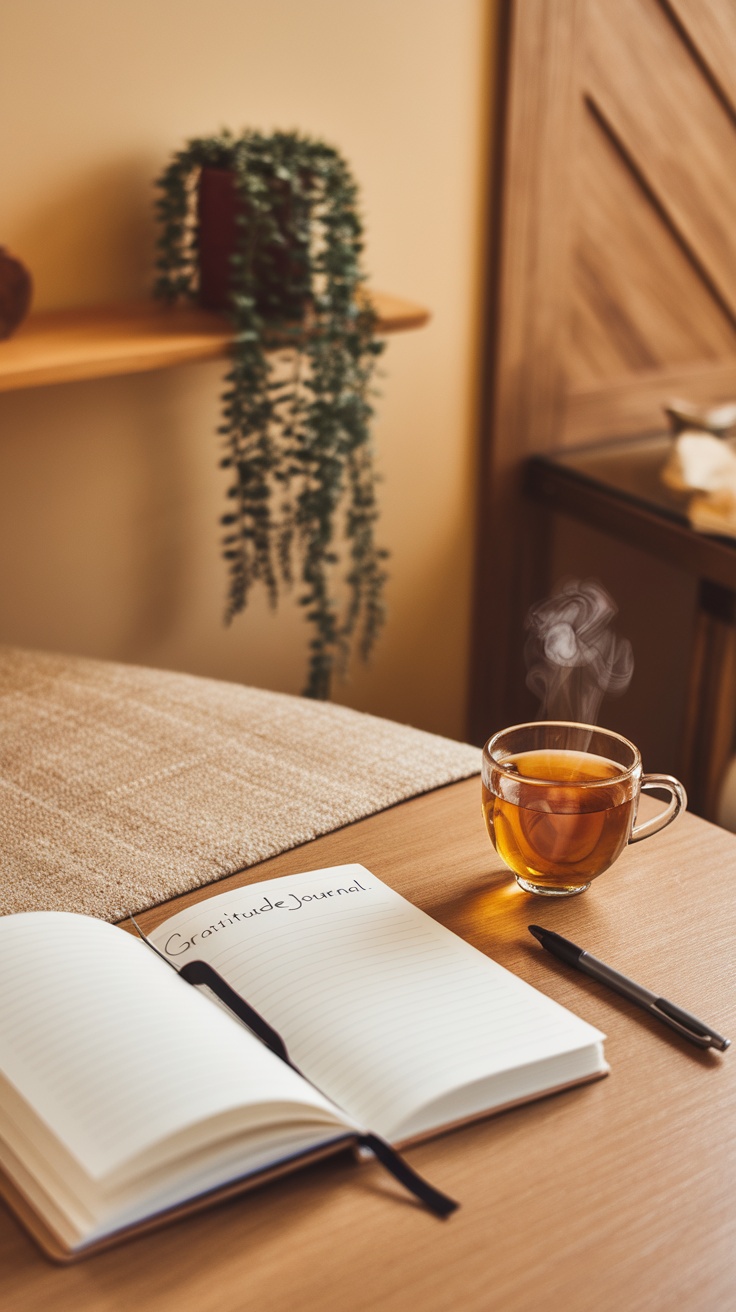
Gratitude journaling is a powerful tool for shifting your mindset. The image shows a cozy space with an open journal labeled ‘Gratitude Journal,’ a pen, and a warm cup of tea beside it. This scene perfectly captures the essence of creating a personal moment to reflect on what you appreciate in life.
Taking a few minutes each day to write down things you are grateful for can help reduce stress and anxiety. It encourages positive thinking and allows you to focus on the good, even during tough times. The soothing color palette of the room, with plants in the background, promotes a sense of calm, making it an ideal setting for such mindfulness exercises.
To start, find a quiet place, grab your favorite drink, and let your thoughts flow onto the pages. Write down three to five things you appreciate each day. It could be as simple as enjoying a cup of tea or the warmth of the sun. Over time, this practice can transform your outlook and reduce those pesky feelings of anxiety.
Body Scan Meditation for Stress Relief
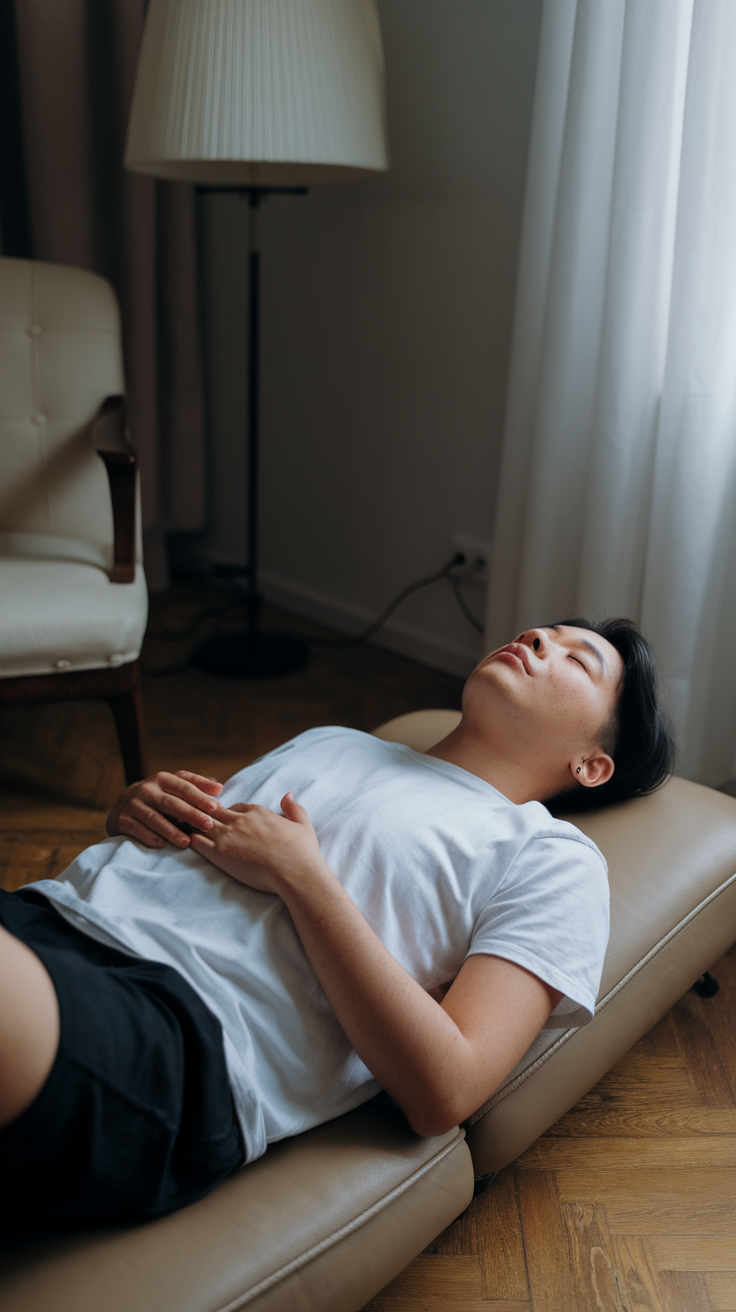
Body scan meditation is a simple yet powerful mindfulness exercise. This technique helps you tune into your body, promoting relaxation and reducing tension.
In a typical body scan, you’ll lie down comfortably, just like our friend in the image. Start by focusing on your toes, noticing any sensations. Gradually move up through your feet, legs, and all the way to your head. This method allows you to connect with your body, releasing any stress you might be holding.
Practicing body scan meditation regularly can lead to improved mental clarity and a greater sense of peace. When stress and anxiety seem overwhelming, taking a few minutes to perform this mindfulness exercise can provide a refreshing break.
Progressive Muscle Relaxation for Tension Release

Progressive muscle relaxation is a great way to relieve stress and anxiety. In this practice, you focus on tensing and then relaxing different muscle groups in your body. This simple exercise helps to enhance your awareness of physical sensations and promotes a sense of calm.
The image shows a person sitting comfortably in a chair, eyes closed, with a relaxed posture. This visual captures the essence of mindfulness exercises. It reflects a moment of peace and focus on oneself, which is key to effective muscle relaxation.
To start, find a quiet space where you can sit or lie down comfortably. Take a few deep breaths to settle in. Then, begin by tensing the muscles in your feet, holding the tension for a few seconds, and then releasing. Move up to your calves, thighs, and so on, all the way to your head. This practice can help you identify where you hold tension and learn to let it go.
Creative Expression through Art Therapy

Art therapy is a fantastic way to express feelings and reduce stress. The image shows a vibrant painting of a woman in a meditative pose, conveying peace and reflection. The bright colors around her create a lively backdrop that captures the essence of creativity and mindfulness.
Engaging in art can be a powerful mindfulness exercise. When you paint, draw, or craft, you focus on the activity, allowing your mind to relax. This practice helps in letting go of anxious thoughts, similar to how the subject in the painting seems immersed in her moment.
Creating art is not about the end product. It’s about the experience and the emotions that come with it. You don’t need to be an expert; just let your feelings flow onto the canvas. Allowing yourself to create can lead to a sense of fulfillment and relief from everyday stressors.
Daily Mindfulness Rituals for Living in the Moment
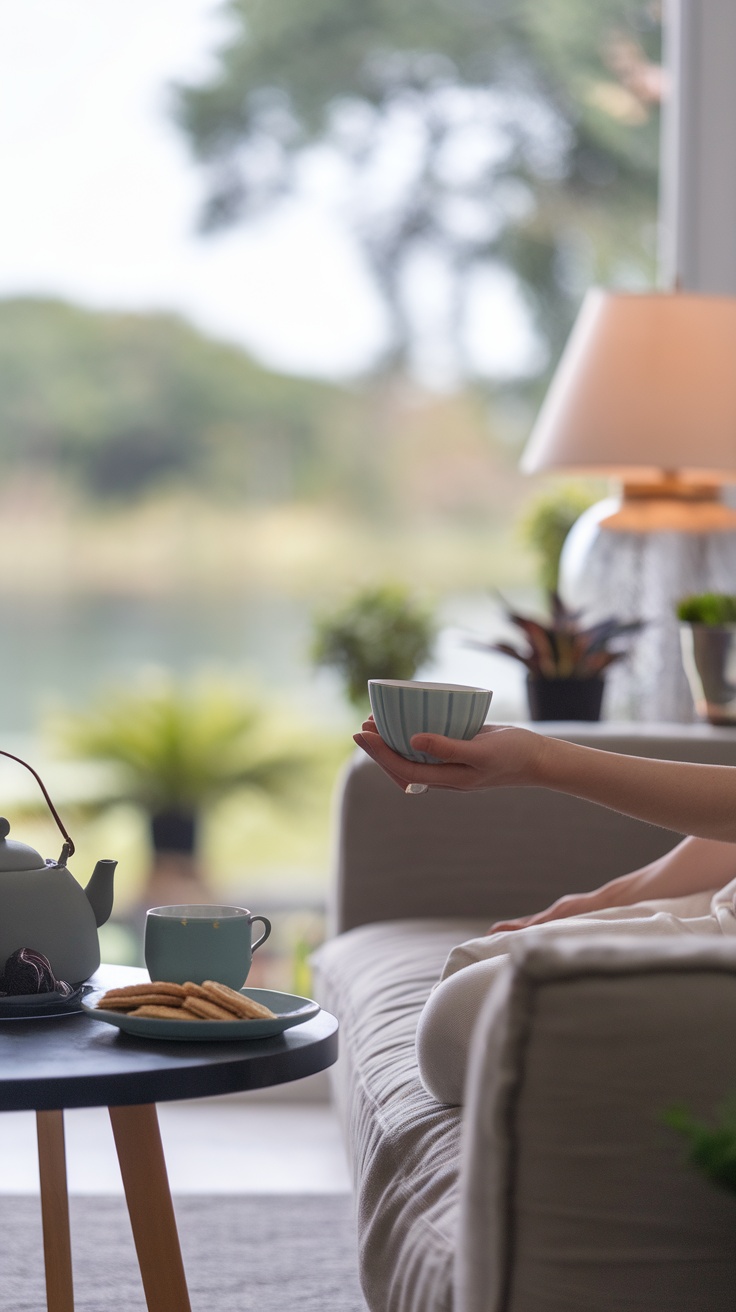
Picture yourself in a cozy space, perhaps on a comfortable couch, holding a warm cup of tea. This scene captures the essence of daily mindfulness rituals perfectly. The gentle light from a nearby lamp and the serene view outside remind us to pause and appreciate the present moment.
When we engage in mindfulness exercises like this, we allow ourselves to let go of stress and anxiety. Taking a moment to sip tea or enjoy a snack can be a small yet powerful practice. It encourages us to focus on our senses—the warmth of the cup, the aroma of the tea, and even the taste of a sweet treat.
Creating rituals around these moments can enhance our ability to live in the now. Whether it’s a morning coffee, an afternoon tea break, or evening relaxation, these simple practices help ground us. They serve as reminders to breathe, reflect, and reconnect with ourselves.
Mindful Eating for Awareness of Food
Mindful eating can transform how we experience meals.
When you sit down to eat, take a moment to really look at your meal. Notice the colors, shapes, and textures. This awareness not only enhances enjoyment but also helps you tune into your body’s hunger signals.
As you eat, try to eliminate distractions. Put away your phone and turn off the TV. Focus on each bite. Feel the flavors and textures as you chew. This simple act can reduce stress and anxiety surrounding meals. Remember that eating is not just about fueling your body; it’s also about savoring the experience.
By practicing mindfulness exercises like this, you connect more deeply with your food. This connection can lead to healthier choices and a more balanced relationship with eating.

